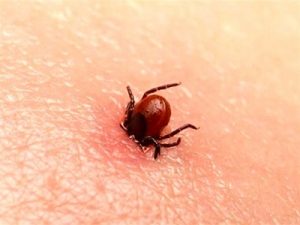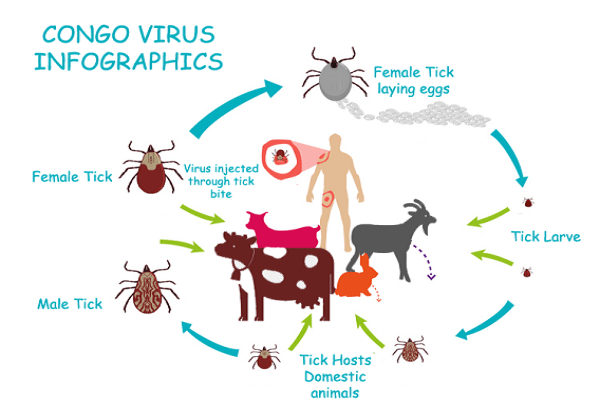What we need to know about Crimean Congo fever
Crimean Congo Hemorrhagic fever (CCHF) is a viral-infectious disease caused by a virus of the Bunyaviridae family and the genus Nairovirus. The virus has a protein coating and its structure is 85 to 100 nanometers in diameter and belongs to the group of single-stranded RNAs. In order to be safe from the complications of this disease, it is necessary to be informed about the conditions of transmission and prevention of its infection. The obvious symptoms of this disease are fever and bleeding. The virus is also known to be a common disease between animals and humans. The disease was first observed in the Crimea and Congo region. The disease has been reported with similar complications in the above areas. That is why this infectious disease is known as Crimean Congo hemorrhagic fever (CCHF). The disease is not currently vaccinated and is highly contagious.
What is the prevalence of Crimean Congo fever?
Complications of Crimean Congo hemorrhagic fever (CCHF) appear in patients within 3 to 7 days. Of course, these symptoms will appear sooner if infected with Hyalomm in humans. Direct tick bites show their effects sooner than in contact with infected humans and animals. The virus is transmitted from bites, contact with infected animals, especially at the time of its sacrifice, and direct contact with the body of a person who has died from the disease, and are the means of transmission of the disease. This disease has symptoms that should be taken immediately if observed, otherwise it will be fatal.

What are the symptoms of CCHF?
Crimean Congo hemorrhagic fever (CCHF) has symptoms that, if observed, should be referred immediately to a hospital or physician specializing in infectious diseases. Symptoms such as;
- Headache
- Vertigo
- Sudden onset of high fever
- Pain in the back
- Abdominal pain
- Burning face
- Pain and stiffness in the neck area
- There are red grains called petechiae.
- Nausea and vomiting
- Redness of the eyes
- Pain in the joints
- Feeling dizzy
- Severe mood swings
- Depression and insomnia
Bleeding and bruising: Of course, bleeding may appear from the third to the fifth day. The bleeding may also continue for 2 to 3 days and eventually 2 weeks. Bleeding may occur in the form of petechiae or mucosal and cutaneous bleeding or severe bleeding of the mucous membranes and skin. Bleeding from the nose and gastrointestinal tract, which causes the stool to turn black, is one of the most common types of bleeding.

Who is at risk for this disease?
Some people may be at higher risk for Crimean Congo fever due to the wrong conditions and habits.
- People who work in animal care.
- Butchers and people who work in the butcher shop.
- People who are in the business of slaughtering animals.
- People who work in health centers such as
- Hospitals or clinics and are in contact with infeceted people with the disease.
- People who drink unboiled milk or eat raw or uncooked meat.
What are the ways to diagnose CCHF?
Diagnosis of Crimean Congo fever is possible through its complications or through laboratory diagnosis. If the above-mentioned complications occur in a person, it can be concluded that the person has contracted the Crimean Congo fever virus. Laboratory diagnosis also denies or confirms the disease.
What is the diagnosis of Crimean Congo fever laboratory tests ?
Crimean Congo hemorrhagic fever (CCHF) virus and disease are detected by testing. Diagnosis of the disease in individuals is made by detecting blood samples using molecular tests. Because patients with the virus do not produce antibody responses in the first few days of illness. Biological care should be taken at the time of testing on samples of patients with the virus. Because working on laboratory samples carries a high biological risk. Laboratory samples should be inactivated using virulence or gamma rays, heat, etc.
Laboratory diagnosis by performing tests such as antigen detection
Enzyme-related immunological assays
RT_PCR Reverse transcriptase polymerase chain reaction method
Isolation of virus from cell culture
SERUM NEUTRALIZATION TEST
What are the ways to prevent Crimean Congo fever?
- Wash your hands with soap and water if you are in contact with a patient with Crimean Congo fever.
- Avoid direct contact with the saliva, blood, feces, vomit, and urine of a person with the disease.
- People who come in contact with animals, if you see ticks on your body and the animal, separate it.
- Eliminate the mite with the help of a doctor or veterinarian or acaricide spray.
- The meat should be thoroughly cooked and kept in the freezer for 24 hours.
- Be sure to boil the milk before consumption.
- Avoid contact with the clothes of sick or deceased people due to this disease.
- Avoid eating raw liver
What is the appropriate action if you have this disease?
People should be contacted immediately if they come into contact with infected animals and patients or those who have died of Crimean Congo fever. Also report the date of contact with animals or sick people to the doctor.

Conclusion
Crimean Congo hemorrhagic fever (CCHF) is an infectious and viral disease that is common between humans and animals. This disease can be easily prevented if some health issues are observed and preventive measures are applied.


